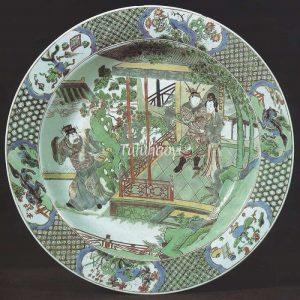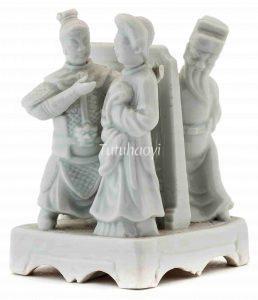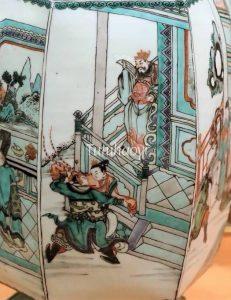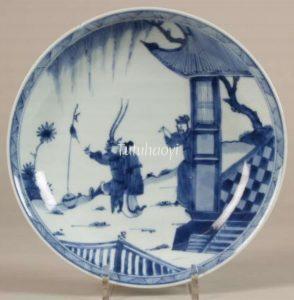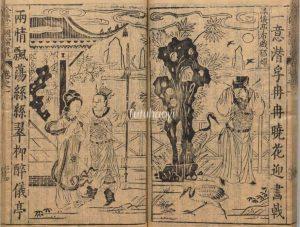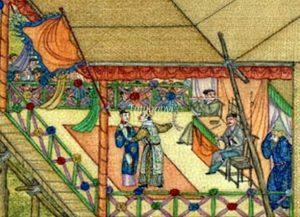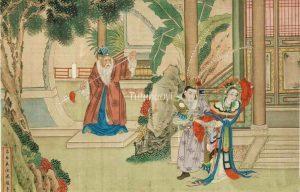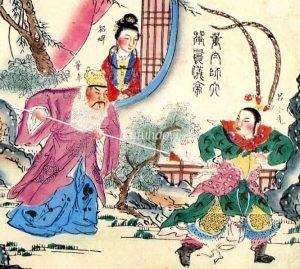The Couple’s Tryst in the Phoenix Pavilion Making Dong Zhuo Fly into a Fury
董卓大闹凤仪亭
© Tutuhaoyi.com owns the copyright of the description content for the images attached. Quoting all or part of the description content on this page is permitted ONLY IF ‘Tutuhaoyi.com’ is clearly acknowledged anywhere your quote is produced unless stated otherwise. (本页描述内容版权归Tutuhaoyi.com所有,转发或引用需注明 “Tutuhaoyi.com”, 侵权必究, 已注开源信息的条目除外。)
Dong Zhuo (董卓 d. 192), a tyrannic warlord rising to power at the end of the Han dynasty, caused great concern among courtiers and officials. Wang Yun (王允), the Minister Over the Masses (司徒 Situ), was entrusted to figure out a plan to bring him down. Dong Zhuo was particularly powerful because he managed to ally with the invincible young general Lv Bu (吕布 Lü Bu), who he had adopted as his son. Wang Yun thought if he could open a rift between the two, then it would be the end of Dong.
Wang Yun first invited Lv Bu to his house to reunite him with his long-lost sweetheart Diaochan (貂蝉), who was then in Wang’s custody. The couple rekindled the passion immediately and could not wait to be together again. Then, Wang Yun treated Dong for dinner at home during which the lecherous lord was drooling over Diaochan, duly falling into Wang’s trap. Leaping at the chance, Wang Yun offered to marry Diaochan to Dong and Dong readily accepted.
When Lv Bu learned that Dong now had Diaochan in his back chambers, he was furious but had to repress his anger. One day, Lv Bu seized an opportunity to have a rendezvous with Diaochan in the back garden of Dong’s residence when Dong was in audience with the emperor. Realising Lv Bu’s absence from his side, Dong hurried back. Seeing the young couple together in the Phoenix Pavilion, Dong flipped his wig and charged at Lv Bu with Lv’s halberd. The seed of dissension was planted between the two. Without his right-hand man’s support, Dong’s power was weakened, which eventually resulted in his downfall.
One of the earliest sources of this story scene is found in a Yuan-dynasty (1271–1368) play entitled The Stratagem of Interlocking Rings (连环计 Lian Huan Ji) involving the intriguing plot of ménage à trois. The play by an anonymous author predates Romance of the Three Kingdoms (三国演义), one of the four great novels of Chinese classical literature, whose earliest preface dated 1494. Chapter Eight of the novel has full-fledged account of this story.
Reference:
Ni, Yibin (倪亦斌)《王允貂蝉合谋连环计,董卓吕布翻脸成仇敌》, Reader’s Taste《读者欣赏》 (October 2017): 114-119
Fig 1: porcelain dish with overglaze enamelled decoration, Kangxi period (1662–1722), Qing dynasty, courtesy of Museum des Kunsthandwerks, Leipzig, Germany
Fig 2: porcelain sculpture, Dehua ware, Kangxi period (1662–1722), Qing dynasty, formerly The Jie Rui Tang Collection
Fig 3: porcelain plate with underglaze blue decoration, Kangxi period (1662–1722), Qing dynasty, courtesy of the Museum of Fine Arts, Boston, USA
Fig 4: porcelain lantern with overglaze enamelled decoration (detail), Kangxi period (1662–1722), Qing dynasty, courtesy of National Gallery of Art, Washington D. C.
Fig 5: porcelain plate with underglaze blue decoration, Kangxi period (1662–1722), Qing dynasty, courtesy of The Princessehof Ceramics Museum, Leeuwarden, the Netherlands
Fig 6: porcelain plate with underglaze blue decoration, Kangxi period (1662–1722), Qing dynasty, courtesy of The Princessehof Ceramics Museum, Leeuwarden, the Netherlands
Fig 7: illustration, woodblock print, Ming dynasty (1368–1644)
Fig 8: handscroll (detail), ink and colour on silk, Qianlong period (1736–95), Qing dynasty, courtesy of the National Palace Museum, Taipei
Fig 9: handscroll (detail), ink and ochre on paper, Shen Yuan (沈源), Qianlong period (1736–95), Qing dynasty, courtesy of the National Palace Museum, Taipei
Fig 10: album leaf (detail), ink and colour on silk, Qing dynasty (1644–1911), courtesy of Tianjin Museum, China
Fig 11: new-year colour print (detail), Qing dynasty (1644–1911), Yangliuqing (杨柳青), Tianjin, China
Fig 12: fresco, Republic period (1911–49), the Long Corridor of the Summer Palace, Beijing
